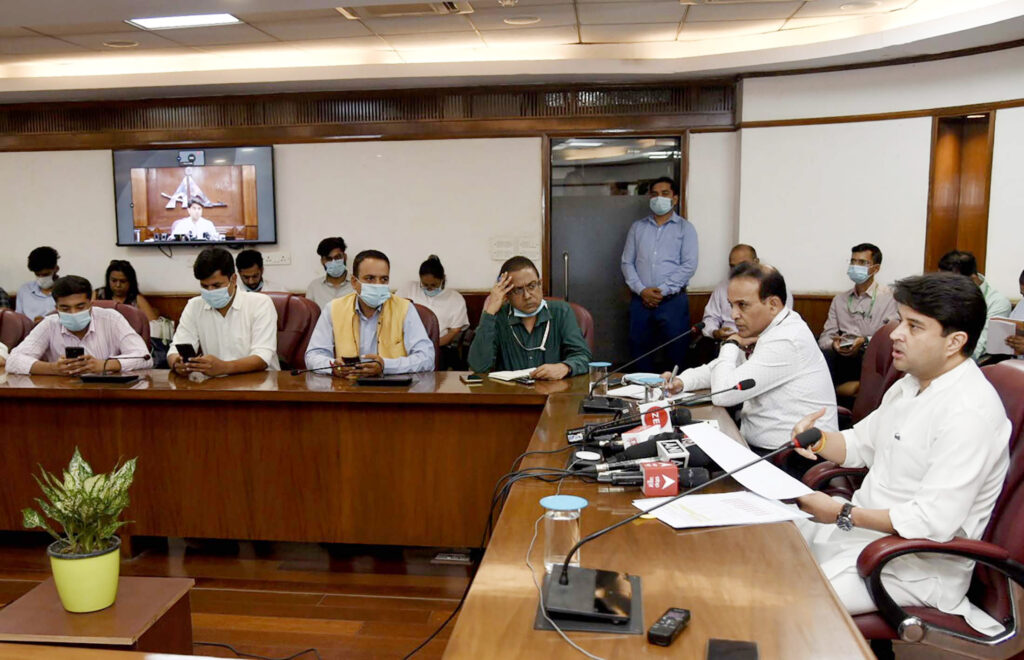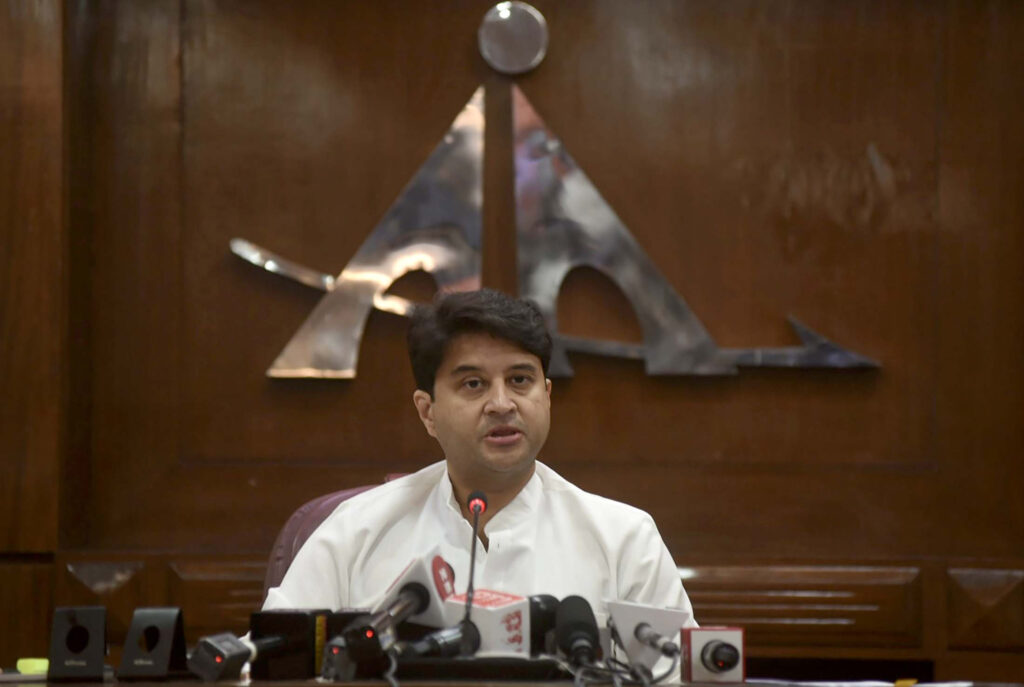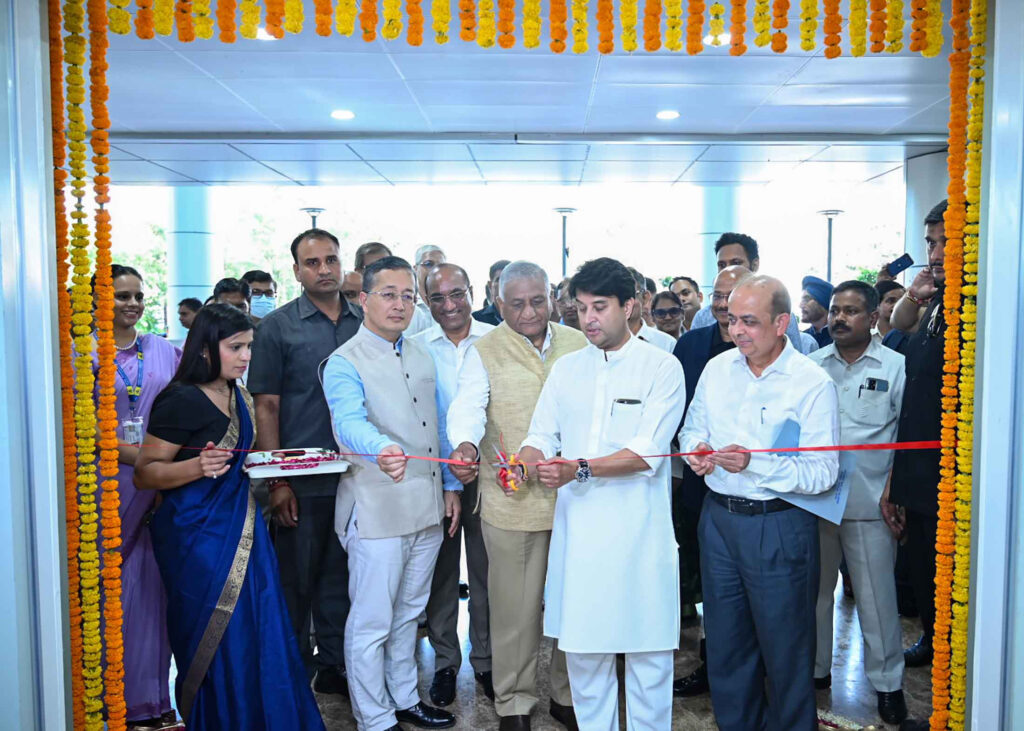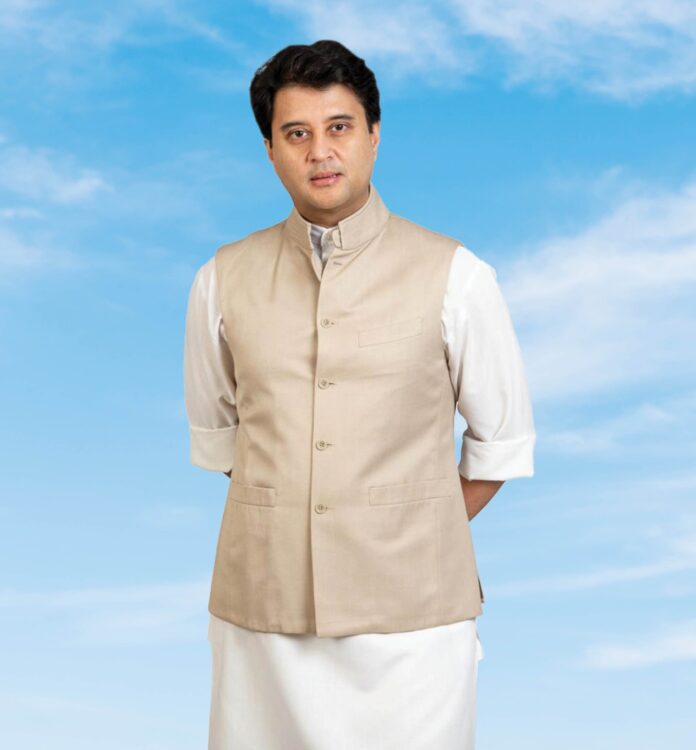By Kamal Shah
Under his command Indian civil aviation has raised the bar and placed its carriers in a pole position. In this wide-ranging, no holds barred, one one-on-one interview Jyotiraditya Scindia shares his views on the many aspects of the sector and plots a course for an exciting flight ahead. Despite the supply chain problems that have affected the world he is confident, buoyant, and noticeably clear about his priorities. With as many as five new aircraft being pressed into service each month the capacity will get a boost as will the levels of service. A doubling of airports, ease of business, the need of establishing an international hub and promoting spiritual, sports and leisure tourism, Scindia is determined to ensure that India is the Powerhouse of Aviation by 2030.
Q 1. India is acknowledged as spearheading the resurgence of aviation in the post-Covid era.
What do you think are the primary contributory factors? How much credit can be attributed to government leadership and policies?
Let me start at the very beginning. International aerospace has been through challenging times in the COVID period. A period where infrastructure was dormant, planes were on the ground, and airlines went through an exceedingly difficult period. But suffice to say there has been a V-shaped recovery in the civil aviation space in India particularly, and demand has climbed up like a Phoenix. Pre-covid, we had a day high of 4,20,000 passengers. In April and May of this year, which is the lean season, we had about 420,000 passengers. On the 25th of November of this year, we had 4,67,000 passengers. If you look at the pre-COVID high, we did about 144 million domestic passengers. I am optimistic that this year we will close upwards of 150 million for domestic traffic. Similarly, on the international front pre-COVID, we did a high of 1,05,882 passengers per day. We broke that record in the month of November with about 1,06,827 passengers. The situation has turned completely on its head. You today have a situation where you have millions and millions who want to fly, but not enough aircraft. And that is because there are supply chain issues with all the main manufacturers because they all cut back during COVID forecasting and dropped in orders and it turned the other way around.
Nevertheless, we are looking at the supply of between two to five aircraft per month from now onwards. Air India’s first A-350 has already landed in India, which will be used for domestic operations for a couple of months before flying internationally. The Civil Aviation Ministry must play the role of a facilitator and not a regulator. That is why, as you are aware, as soon as I took over in 2021, we set up six advisory committees, one each for airlines, airports, one for MROs, one for FTOs, one for regional airlines, one for aerospace manufacturing, and to engage with them as to where the pain points are and to resolve the pain points. Now the question is why that strategy? The civil aviation ecosystem’s success lies in our success. And therefore, it is time that we look at not only airports and planes, but we look at the sub-plantation of the full ecosystem in India, which means MROs, which means FTOs, which means ground handling, which means drones, which means futuristic in the years to come, eVTOLs, all those systems need to be in place.
Along with that, also it is important to look at institutional building, because if one is looking at multiple areas of growth in the civil aviation sector then the institutional backup has to be robust, which means DGCA, BCAS, airports authority of India with their ATCOs, AERA (Airport Economic Regulatory Authority) have to be reviewed. In the last year and a half, we have beefed up the number of personnel across each one of these institutions, therefore preparing it, preparing each of them for 2030 and the demand that will accrue during that period.

Q 2. Aviation analysts are beginning to believe that Indian aviation has come of age and its reliance on Gulf and Southeast Asian carriers, or growing traffic will decline in coming years?
It is a reality, not a belief, the Indian aviation sector has taken its flight. These are exciting times, especially for a sector that saw the most difficult days during the COVID-19 pandemic. We are on a trajectory of rapid growth; in November 2023 we created a record of carrying 4,67,451 domestic passengers – this figure has surpassed the pre-COVID high.
Under the leadership of Prime Minister Narendra Modi, we have doubled the number of airports. Until 2014, India only had seventy-four airports, in the past 9 years we have added seventy-five airports/heliports/water aerodromes to this list and now have 149 airports.
We are also making positive policy reforms to ensure ‘ease of business’ in the country: Aircraft (First Amendment) Rules, 2023 were officially notified on October 10, 2023. As a part of these amendments, the validity of licenses in relation to Airline Transport Pilot License (ATPL) and Commercial Pilot License (CPL) holders have been increased from five years to ten years along with various amendments encouraging ease business.
IndiGo has placed an order of five hundred Airbus A320 family aircraft and Air India has formalized deal for 470 Airbus and Boeing Aircraft. These new long-haul aircrafts will establish Indian airlines’ dominance in the international sector also. This is also inspiring other airlines to expand. In 2023 we have connected to the following new destinations: Nairobi, Jakarta, Tiblisi, Baku, Kualanamu, Vienna, Copenhagen, Milan, Amsterdam, Gatwick, Mauritius, Minsk, and Entebbe.
Many services/functions of DGCA have been made live through the e-GCA platform. The eGCA project aims to provide transparency, accountability, and ease of doing business through digital transformation of DGCA process and functions which will bring in long term impact on its service delivery. The project has also helped in ensuring that services are delivered in a time-bound manner. Airlines are thus confidently placing orders for inducting new substantial number of aircrafts. During the year 2023, a record number of 112 aircraft were inducted by scheduled airlines, as against eighty-one aircraft that were inducted in 2022 – which is a jump of 38%.
Together with all stakeholders, we are working towards making the aviation sector Atmanirbhar.
Q 3. Indian air traffic has thus far been confined to Indians and the Indian diaspora abroad. Can India be transformed as the (a) viable alternative to Gulf carriers as the stopover point on the east-west routes; (b). lure more tourists since the hospitality sector has also witnessed phenomenal growth and are highlighting world-class hotels?
I look at really what I think is most important, to create an international hub in India. For time immemorial, our hubs have been across our Western border or across our Eastern border. I believe that one does need economies of scale to be able to pivot and create a hub in India. That was not possible earlier, with the numbers that we had in 2014 and pre-2014, where we had only six crore domestic passengers. Today we have 14.5 crore domestic passengers, and I forecast this number to go upwards of 20 crores, and today we have six crore international passengers. That number is expected to increase by double digits, then it augurs for the creation of an international hub in India, and we are starting with Delhi. We are today in talks with DIAL (Delhi International Airport Limited), Air India and Indigo to make Delhi the first international hub. Once we have done that, we will also coordinate with other related ministries, and get them on board to make that into a reality. However, an international hub in India is in the offering sooner rather than later. Due to the potential, I think that in the next decade, I would like to see not only a single international hub but multiple international hubs in India.

Q 4. Prime Minister Modi has been promoting the country’s rich cultural heritage during his visits abroad. How is the Ministry of Civil Aviation planning to enhance air connectivity so that cultural and historical richness for tourists can be exploited to its potential? Have the past shortcomings been fully overcome?
A good question, and something remarkably close to my heart. I believe that India has arisen today as an economic power. We were the 10th largest economy in 2014. In nine and a half years, we have moved to the fifth-largest economy. By 2027, the IMF and the World Bank and international agencies are predicting that we will move to the third-largest economy in the world ahead of Germany and Japan. Whilst we are transcending on that path of growing into the top three economies, we are today the fifth largest stock market in terms of market capitalization at close to 4.3 trillion, mirroring our GDP. India has tremendous potential of being an Adhyatmik Shakti, a philosophical power. And the fact that Prime Minister, Modi, has driven this himself from International Yoga Day, which was celebrated at the United Nations, to the resurgence of India’s cultural heritage from Kedarnath to Badrinath to Mahakalal, to Kashi to now Ayodhya.
We at the Civil Aviation Ministry are resolute in our commitment to development on the same path. The difference is visible, the airports that were constructed earlier and airports that are being constructed now over the last two and a half years, are completely different. Earlier the airport structures had glass and tile facades, which looked like any other airport in the world. However, the airports being constructed today all reflect the local culture and the material used is also largely local. Facades facing the city and airside as well as the interior exhibit the local sanskriti, the local sanskar, and the local kala of that city. The Ayodhya Airport is one such example reflecting the local culture and values of the area. Similarly, Gwalior and Kolhapur Airport will reflect the local features. In the days to come, when one arrives at the destination, one must get a vignette of the experience of what that local culture is at the airport, which is your first doorway to that city. All the airports being designed now will exhibit the local art culture, sanskara and sanskirti, internally and externally.
As examples, Pune and Kolhapur airports will use the local black Maratha Stone on the facade. Everything has been localized, vocal for local and local for global. And that is manifested very clearly in our airports. The new Chennai terminal that the Prime Minister inaugurated also had all local art forms externally and internally, this is mandatory and no longer an option.
Q 5. You are on record to having stated that 96% of India is a potential flyer. What plans does civil aviation have to make flying more attractive and less expensive for domestic and international flyers? Do you think the policy of increased private participation in aviation has contributed to accelerating the pace of attaining govt goals in aviation and tourism?
Under the leadership of Prime Minister, Modi, we have witnessed two phenomena, the first being the democratization of civil aviation. Earlier, civil aviation was limited as a service available only to a few. Today, through the rapid transformation of infrastructure, rapid advancement of fleet size, as well as Ude Desh Ka Aam Nagarik, the UDAN scheme, has enabled seen civil aviation to reach out to many millions. The number of airports has doubled from 74 to 149, fleet size has increased from 400 to 700+ and Indian airlines have placed the largest aircraft orders in the history of civil aviation globally with Air India ordering 470 and Indigo ordering 500 aircraft.
UDAN has given birth to not only new routes but also enabled almost 1.3 crore passengers to board their first flight. Under the scheme, we have operated about 2.75 lakh flights. But UDAN is most important to the country having witnessed the establishment of five new regional airlines, Star Air, India One Air, Fly Big, Fly 91, and Air Taxi.
The Civil Aviation Ministry is looking at a three-A strategy, Accessibility, Availability and Affordability.
Q 6. Is our infrastructure by way of airports and networks, transportation, and maintenance keeping pace with the headlining making orders given to Airbus and Boeing by Indian carriers, particularly Air India and Indigo?
Definitely. As I mentioned before, we have doubled the number of airports to 149 airports/heliports and water aerodromes. In the first quarter of 2024, more than ten airport infrastructure projects are set to be inaugurated/foundation stone. Never has the Indian aviation sector witnessed this pace of growth – where we are not just building airports but also enhancing our capacities and ensuring that the entire aviation ecosystem grows together. Delhi Airport now has a fourth runway and an Eastern Cross Taxiway (ECT) which is the first-of-its-kind cross-taxiway and which has enhanced India’s global aviation footprint by joining other 10 airports ((including Singapore; Changi Airport or Germany’s Leipzig/Halle Airport) around the world to have this unique facility of elevated taxiways to facilitate aircraft transfers. We are building twin airports in metro city – for example in the Delhi-NCR region, apart from the Delhi Airport, an airport is coming up in Jewar; Goa has two airports – Goa Airport and the newly inaugurated Mopa airport; similarly, a new airport is being built in Navi Mumbai.
If you look at the policy front then, keeping in view India’s growing aviation market, technology, and skill base, we announced new MRO Guidelines on 1st September 2021 to create a conducive environment towards making India a global hub of MRO. We also developed the New FTO policy, wherein airport royalty payments (revenue share payment by FTOs to AAI) was abolished and land rentals were significantly rationalized. The number of Flying training organisations (FTOs) has gone up from 29 in June 2016 to 36 currently. The number of Commercial Pilot Licenses (CPLs) issued by DGCA during 2023 stood at 1622, an all-time high. Women pilots constitute 18.12% of this number, which is 22.5% more than last year. We plan to attain self-reliance in the manufacturing of aircraft parts with the setting up of a private manufacturing unit for C295 in Gujarat. In 2021, Boeing announced the addition of a new production line under its joint venture, the Tata Boeing Aerospace Limited (TBAL) to manufacture complex structures for the 737 airplanes; and Safran Group, a French multinational aviation company, has started setting up its largest and first aircraft engine MRO facility in India with an initial investment of $150 million.

Q 7. Air congestion and consequent flight delays are issues that still need to be addressed. What are MOCA’s plans to overcome these constraints as the country embarks on its growth trajectory?
We are constantly working to resolve both the issues. We are looking at both air congestion and enhancement of terminal side capacity:
A. Air Traffic Management: Earlier there was no cap on ATM (Air Traffic Movement) because of which airlines and airport operators were scheduling many flights during peak hour period and not dividing it throughout the day. Now, we are keeping a check on the number of ATMs and every airline and airport operator conducts hourly analysis of the city side and terminal side capacity of the airport so that flights can be scheduled most efficiently – and congestion is also avoided. The result is visible this year – where even in the festive/holiday season when our daily passenger count when above 4.67 lakh passengers, there were no congestion days and not a single complaint of congestion at the major airports. I also believe that technological advancements like the installation of DigiYatra at 13 airports have helped in the smooth travel of our passengers.
B. Mitigation measures to tackle terminal congestion: On the terminal congestion part, we have taken mitigation measures to tackle Congestion at Major Airports:
● Waiting time screens have been installed at entry and police naka points to apprise passengers about the waiting time.
● Additional entry gates have been opened.
● Airport Operators installed 2D bar code scanners at entry gates to facilitate automated entry and airlines advised to ensure bar code on tickets issued to passengers so that the same can be readable by bar code scanners to facilitate smooth entry of passengers.
● Support workforce has been deployed to assist passengers.
● Additional space at airports for passenger related activities created by way of demolition/shifting of offices/ lounges/retail outlets including Waiting Lounge, Retail Outlets, Office spaces have been demolished at Delhi, Mumbai, and other airports
● Waiting area has been increased both at entry and at security hold area.
● Airport Operators have been advised to install baggage drop facilities as per the availability of the space.
● Airlines have been advised to deploy sufficient workforce at all check-in/ baggage drop counters.
● Number of X- ray machines have been significantly increased at pre-embarkation security points.
● Use of social media platforms to provide real- time updates to passengers to make airport transit seamless.
● Digi Yatra has been launched in a phased manner at airports for seamless travel experience.
● Monitoring on daily basis at level of Airport operators, Airlines and Ministry of Civil Aviation for ensuring compliance of mitigation measures.
● We are also working with Ministry of Home Affairs to ensure 100% staffing of the immigration counters and for increasing the CISF deployment to staff the sanctioned strength at the respective airports through capacity addition. We have resolved all issues of congestion and looked at terminal and air congestion at 16 airports: six major airports (Delhi, Mumbai, Bengaluru, Hyderabad, Chennai and Kolkata) and ten other identified airports (Goa Dabolim, Bhubaneswar, Chandigarh, Patna, Jaipur, Guwahati, Lucknow, Ahmedabad, Trivandrum and Cochin). More than 3,000 additional CISF personnel are being posted across sixteen major airports to tackle congestion.
C. Flexible Use of Airspace: In the past, about 40% of the airspace was unavailable for civilian use. This resulted in aircraft adopting circuitous routes to reach their destinations – leading to inefficient use of fuel and time along with avoidable extra expenditure. IAF controls 30% of national airspace out of which 30% has been released as upper airspace under Flexible Use of Airspace. As part of ‘Atmanirbhar Bharat,’ IAF has agreed to release these portions of airspace for civilian use. Till date 129 Conditional Routes (CDRs) have been promulgated. This will lead to significant savings in flight time, fuel usage and a reduction in carbon emission. The potential savings to the airlines will be to the tune of INR1000 crores per annum. Total savings so far from August 2020- Rs.640.7 crore and total CO2 reduction is 1.37 lakh tons. This helps in freeing up space and economizing operations of air travel.
Q 8. Some of the issues that come under scrutiny include more Cat III airports, upgraded air traffic controls, a stronger encouragement to the MRO sector, tighter controls on snag sheets and “Go’ item lists, more schools for crew and staff training, and investment in simulators.
The period between 10 December and 10 February each year is usually considered as the fog period. A fog day over an aerodrome is considered whenever the Runway Visual Range (RVR) drops below 550 m due to the onset of fog. Every year, DGCA undertakes an exercise to ensure that airline and aerodrome operators take action to prepare themselves for fog conditions well in advance so that disruptions in services in terms of flight cancellations and diversions are reduced. Towards this end, DGCA engages with all stakeholders viz. MET Department, Aerodrome and Airlines Operators in the first week of November 2023 to check on the readiness of the required support systems on ground and the operators in terms of aircraft availability and trained crew for operations in CAT II/III conditions.
Six airports have CAT III landing facility, and the flights can land with RVR 75 m/RVR 50 m including Delhi, Jaipur, Amritsar, Lucknow, Kolkata, and Bengaluru. As of date, 4804 flight crew qualified for CAT II /CAT III are available with various airlines, including 2979 Captains and 1825 Co-pilots. For the current year also DGCA is continuously analyzing the situation, we are in touch with the airlines so that qualified crew members and aircraft are always available to provide fast air travel experience for our passengers.
We have looked at the urgent requirement of more human resources to effectively respond to the burgeoning demands and enhance the institutional infrastructure. With the swift operations of new airports in the country, there has been a corresponding rise in the demand for relevant human resources. It is important to look at the jump from 2014 onwards, total number of ATCOs in the last 9 years has shown jump of almost 100% taking their number up from 2305 employees in 2014 to 4554 in 2023; we have increased number of
Employees sanctioned under Airport Economic Regulatory Authority (AERA) from 32(2014) to 43 (2023) thus indicating an increase of almost 35 % in the last 9 years; To address Ease of Doing Business Capacity Building has been given priority in DGCA.
Additional posts have been created such that the manpower strength has increased from 1252 in 2014 to 1703 now resulting in an increase of almost 36%; In order to improve Aviation Security, special emphasis has been given on capacity building of BCAS and its employee strength has been increased from 191 in 2014 to 595 now thus indicating an increase of 212% in the last 9 years. Thus, strengthening our institutional backbone to prepare India for greater air traffic of approximately forty-two crores by 2030.
Keeping in view of the growing aviation market, technology, and skill base, we have announced new MRO Guidelines on 1st September 2021. These guidelines inter-alia provide for allotment of land at AAI airports through call of open tenders without levy of any royalty for MRO’s. The new guidelines would further encourage the MRO organizations and OEMs to set up workshops in India and create a conducive environment towards making India global hub for MRO. Recently, I also had the opportunity to inaugurate the AAR Indamer MRO Facility in Nagpur.

Q 9. With sustainability a major global issue and environmental concerns on the front burner what technologies are you harnessing to show that Indian aviation cares … For example, research for alternate fuels.
The Indian domestic passenger air traffic has not only rebounded but has already surpassed pre-pandemic levels, highlighting the pent-up demand for travel and the industry’s adaptability. This growing demand not only requires us to maximize our infrastructure and services but to also be responsible for addressing the environmental impact of our industry. Under Prime Minister Narendra Modi’s commitment towards sustainable development, we are placing significant emphasis on promoting green aviation.
As a sector we are taking important steps towards sustainability, with a focus on promoting the use of Sustainable Aviation Fuel, investing in more fuel-efficient planes, and ensuring that our upcoming infrastructure is environmentally friendly. This will not only help us in reducing our carbon emissions but also present opportunities for investors to facilitate a more robust supply chain, create new job opportunities and promote development of modern technologies for more efficient operations and infrastructure.
I Sustainable Aviation Fuel: Last year with the Ministry of Petroleum and Natural Gas India’s first domestic commercial flight on indigenous feedstock & SAF was launched. It was a modest beginning with one percent Sustainable Aviation Fuel in one flight as a demonstration – and laid the foundation for one percent blending in all flights soon; then taking the percentage of blending even higher. Vistara operated a wide-body aircraft using a 17% blend of SAF and SpiceJet flew on a route (Dehradun to Delhi) using 25% SAF blend.
To realize the goals of decarbonisation of the Aviation Sector, the Ministry of Petroleum and Natural Gas (MoP &; NG) has constituted a Bio-Aviation Turbine Fuel (ATF) Programme Committee to take forward the Bio-ATF programme in the country and promote use of clean fuels. One more development in this field is that the Indian Oil Corporation has decided to set-up a SAF manufacturing facility in the country using LanzaJets ATJ technology. Production of sustainable fuel is expected by 2026.
II. Green Energy: We are encouraging 100% green energy by 2024 and achieving Net Zero by 2030. It is now our mandate that all new airports under any category like -PPP, Greenfield, UDAN will use Renewable Energy. Today there are 149 operational airports including 9 Heliports and 2 Water Aerodromes out of which sixty-two airports are using renewable energy. It is our commitment that by 2025, 121 airports out of these 149 airports will be green and using renewable energy.
III. New aircraft: IndiGo has placed an order of five hundred Airbus A320 family aircraft and Air India has formalised deal for 470 Airbus and Boeing Aircraft. We are certain that these new aircraft will be more efficient – not only in terms of saving time but also saving fuel.
IV. Flexible Use of Airspace: In the past, about 40% of the airspace was unavailable for civilian use. This resulted in aircraft adopting circuitous routes to reach their destinations – leading to inefficient use of fuel and time along with avoidable extra expenditure. IAF controls 30% of national airspace out of which 30% has been released as upper airspace under Flexible Use of Airspace. As part of ‘Atmanirbhar Bharat,’ IAF has agreed to release these portions of airspace for civilian use. Till date 129 Conditional Routes (CDRs) have been promulgated. This will lead to significant savings in flight time, fuel usage and a reduction in carbon emission. The potential savings to the airlines will be to the tune of INR1000 crores per annum. Total savings so far from August 2020- INR.640.7 crore and total CO2 reduction is 1.37 lakh tons.
Q10. India’s regional connectivity scheme, UDAN (Ude Desh ka Aam Nagrik), has aimed to enhance air connectivity to underserved and unserved regions. What are the achievements and challenges faced in implementing this scheme, and what are the plans to expand regional air connectivity?
UDAN (Ude Desh Ka Aam Nagrik) initiative has proved to be instrumental to improve infrastructure and connectivity in India, especially in remote and underserved regions. It is contributing to the overall growth of the civil aviation industry in India. From building airports in areas such as Utkela, Ziro, Cooch Behar to enabling 1.32 crore passengers to board their first UDAN, the scheme has been successful in democratizing the aviation sector. There was a time when the aviation sector was just serving a few, today under the leadership of Prime Minister Narendra Modi Ji, we have empowered Indian travellers and now even ‘हवाई चप्पल पहनने वाला भी कर रहे है हवाई यात्रा.’
Under the scheme, we have commenced 517 routes, seventy-six airports (including nine heliports & 2 Water Aerodromes) have been operationalized, more than 2.5 lakh UDAN flights have been operated and the scheme has given birth to five regional airlines – Star Air, IndiaOne Air, FlyBig, Fly91 and Air Taxi. I am also happy to share that because of the scheme we have provided connectivity to the North-East region through strategic airports including Passighat, Shillong, Tezu, Lilabari, Tezpur & Hollongi. After releasing four versions of UDAN Scheme, we have also released the fifth version, UDAN 5.0, this round of UDAN focuses on Category-2 (20-80 seats) and Category-3 (>80 seats). The Scheme has been formulated after extensive consultation with various stakeholders involved in the system, so that airlines operate in a competitive environment and accordingly, the identification/ development of regional air connectivity routes has been left to market forces such that airlines undertake an assessment of demand and nature of supply required on particular routes and lead the process. Currently, a total of 148 RCS Routes has been awarded under UDAN 5.0, out of which thirty routes have been operationalized till date.
I am delighted to share that we have designed the UDAN 5.1 round specifically for helicopter routes and UDAN 5.2 for aircraft under Category 1A (<9 seats) and Category 1 (<20 seats) operations. The UDAN 5.2 Scheme provides greater operational flexibility to small aircraft operators, by allowing them to operate a maximum of 40% of annually quoted RCS seats and a minimum of 10% of annually quoted RCS seats in any given quarter. This is a testament to our resolve to make air travel ‘accessible and affordable’ to all and especially to citizens living in remote areas.

Q 11. Finally, never has Indian aviation been so vibrant and positive. Who should we attribute credit for charting a new course with you at the helm? Can we say that India has finally figured and sorted out issues to make the sector vibrant?
The credit goes to two, the vision of Prime Minister, Narendra Modi, and all my stakeholders, the airlines, the airports, the FTOs, the MROs, the ground handlers that have created the energy in this space for growth.


